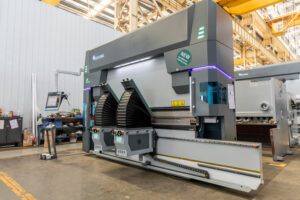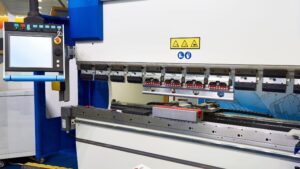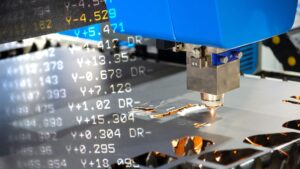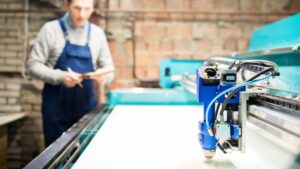The CNC system is the newest update to the pieces of machinery used in the fabrication or manufacturing industry around the globe. With the advancement in technology in every sector, this industry is keeping up at a fascinating rate. With automation and AI, technologies and tools in the manufacturing industry are reaching new heights. The CNC system is one such advancement that companies around the globe are trying to adapt to.
But what exactly is it, and how does it help? In this article, we will take our time to go through the CNC system, how it is beneficial, and most importantly, try to understand its structure and components. More so, we will take our time to understand the types of CNC control systems present in a CNC machine.
If you are new to this field or are an expert already, this will help you familiarize yourself with modern developments in the machines and tools you use regularly. This will also help you make the best use of your machines. Then, without further delay, let us understand the CNC system.
What is A CNC system?
Before we get to what is inside it, let us first try and understand what it is as a whole. So what is a CNC system? A CNC system stands for Computer Numerical Control system that can accept human data and instructions, convert them into machine language, and make the machine work in certain ways to ensure that you get the product you were hoping for.
Let us take the example of a CNC Press brake machine, such as Accurl’s CNC Press Brake EURO PRO 4 ~ 6-Axis. This type of press brake machine comes with in-built CNC systems. So, let us assume that you want to make a part of an automobile, which has complicated bends and angles on a metal sheet. Instead of bending them manually, which can be prone to a lot of human errors and inaccuracy, you rely on the CNC system instead.
You input the data in the CNC system, informing it about the position of the bends, angels, areas, and so on. The system will understand that information, convert it into a language that the machine will understand, and then feed the data to the machine. The machine will pick up the data and start working on the sheet of metal to give you your desired product.
In short, you get exactly what you want without any mistakes or wastage, and also with the least bit of effort and time. The main benefit of a CNC system is that it allows you to manufacture rapidly with the minimum amount of wastage while saving you energy and money.
Types of CNC Control Systems
Now that we have a better understanding of what a CNC system is, we can now move on to numerous CNC Control Systems types. The basic point of differentiation for the various types of CNC control systems can be based on the following factors:
- The kind of communication systems used for operations
- Industry usage and relevant factors
- CNC router machine application
These few factors can help you differentiate different types of CNC control systems. However, generally, you can categorize them as the following types:
Loop Control CNC Controllers
This type of CNC control system works together with the looping mechanisms present in the machines. Together, it helps in gaining control over the machine and executing operations. Now, this category can further be differentiated as open and closed-loop systems.
In the open-loop system, the information is taken from the input device and passed on to the machine through the controller. On the other hand, the close loop system works the other way around. In other words, it brings the feedback from the machine to the system.
Motion Control CNC Controllers
This particular type of CNC control system is the reason why you can get the accurate and precise results that CNC machines are famous for. Here, the CNC control system has two main mechanisms through which it retains control — contouring systems and point-to-point control.
These two mechanisms allow rapid and accurate motions which can move in linear or circular patterns. The CNC control systems also help control the degree and feed rate of the applied motions.
Axis Type CNC Controllers
CNC machines operate on an axis, which decides the range of movements that the machine can do. Currently, there are about five types of CNC Controllers based on axes. Let us take a look:
- 2-axis control
- 5-axis control
- 3-axis control
- 4-axis control
- 5-axis control
These help the machine move along the axes of X and Y. As the number of axes increases, the range and scope of movement also increase. For example, a 2-axis controller will offer you a motion range on the axis of X and Y. But a 2.5-axis will allow you movement on the X, Y, and Z axes.
However, a 3-axis control will allow you movement on the 3 dimensions. Leveling up, a 4-axis control will allow you movement on the three axes, along with rotational movement (on the B axis). The 5-axis control gives the maximum range of motion. It covers the three axes along with rotational movement on the Y and Z axes.
So, these are the different types of CNC control systems that you will find in a CNC machine. Now depending on the type of machine you are using and the purpose of the machine, these systems will vary.
If you want a specific system, Accurl offers customizable machines so that you can make special alterations to your machines to meet your demands and needs. Accurl has been an expert in this field with years of experience. Today, it is one of the top-most providers of such machinery, with the best features and after services.
Why Opt For CNC Control Machines?
We have already covered the main topic of the article, but you must be wondering, is it really necessary to make the transition from the conventional type of machine to a CNC control machine?
Transitions are always difficult as you switch from one technology to another. However, this transition is necessary for you to keep up with changing times. Also, CNC control machines have a bunch of benefits that you can rely on for the development of your business. Let us take a look:
- First of all, it helps you achieve extremely accurate and precise results every time— something that your conventional machines cannot guarantee.
- CNC machines help increase the productivity of your business as they can run for a longer period without stopping
- With such precision and increased productivity, it can help you broaden the scope and opportunities of your business
- It helps you lower the cost of production.
- It is much safer and more stable than conventional machines, with a lower rate of accidents and risks.
- You need not worry about high maintenance drills as CNC machines are very easy and economical to maintain. If anything, they are hassle-free when it comes to maintenance.
Conclusion
So, that is all there is for you to know about CNC Control Systems. They are the modern evolution of traditional manufacturing machines and can help you achieve great new heights in your business.







